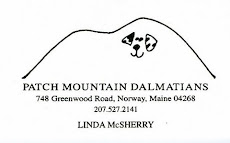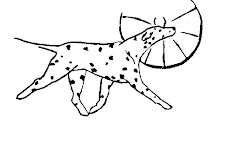
(Waiting on an internet issue before today's picture is up. Sorry!) In the meantime here is a cute picture of Corey - doing his favorite cute trick.
And here is an article about Show vs Pet puppies. I will follow up with more details over the next few days.
>We are often asked to explain the difference between "show" and "pet" quality puppies. I find the difference often hard to explain without leaving the impression that "show" means "good" and "pet" means "bad." I have many times heard breeders (myself included) refer to a puppy in a litter as "just a pet", inferring that there's something wrong with him. What qualities are necessary for a puppy to be labeled a "show quality puppy?" And what lack of qualities cause a puppy to be "just a pet?"
There is often a fine line between what is considered "show" or "pet" quality, and two breeders evaluating the same puppy may come up with different answers, depending on what they value in a dog. For every quality one breeder values, another breeder may decide that it is an undesirable trait, and label the puppy "just a pet." These qualities do not necessarily have to be structural. Many a breeder has agonized over the "absolutely breathtaking" puppy that is a shy violet that could never withstand the rigors of the show circuit.
Usually, to a person with little knowledge of canine structure or the breed standard, there is no difference between the classifications "show" and "pet" unless the puppy in question has some obvious flaw, such as a patch. What it boils down to is this: if you want a Dalmatian as your family pet, and you have no intentions of ever showing, then don't feel that your potential puppy is being downgraded by breeders' jargon, the reference to "pet" quality. More important to you than a straight front, lovely movement, level bite or all those other things "show" people might admire is that your Dal puppy have a great disposition and fit in with your family's lifestyle. And don't apologize to people for having "just a pet." Showing is definitely NOT for everyone!
However, if you are looking for a Dal to show, keep in mind that dog showing is expensive and you want as high a quality puppy as possible to be competitive. If you buy an older puppy or young adult, you have more of an idea of structure and "show quality" than if you buy a young puppy. Many breeders will advertise their older puppies as "show quality" and their younger ones as having "show potential," simply because there are times when even an experienced breeder finds it hard to predict exactly how a young puppy will develop. Sometimes a buyer will ask, "If I buy this 'show puppy' will you guarantee that it will get a championship?" My answer? NO! Why? Because so much depends on the buyer and what he/she does with the puppy after it leaves the house. Will the puppy be socialized, taken places to get used to different people, sounds, and smells? Will the buyer train the puppy correctly? There are many aspects to showing a dog that go far beyond the dog's structure.
Concerned breeders carefully evaluate puppies before choosing a show potential puppy for themselves or their puppy buyers. They want the Dal in the ring with their kennel prefixes to be as outstanding as possible. They want what they consider the best of what they have produced out there speaking well of their breeding programs. Also keep in mind that show quality includes attitude as well as structure and movement. An average Dal that has that "look at me! I'm special!" attitude often has a competitive edge over the more structurally sound dog that is not excited about being in the ring. And don't forget that "there is no perfect dog." There is something about every Dal that someone would like to change: "He's got a great profile, but he holds his tail wrong." "He has a lovely head, but I'd like to see a little more muzzle." "His movement is to die for, but I wish he were an inch shorter!" "He has lovely straight forelegs but lacks shoulder layback." etc...
Even when a breeder keeps a show potential puppy for himself it's usually a matter of trade-offs. He decides what quality or qualities he really wants (or needs) in his line and what traits he's willing to overlook to get them. He might say, for example, "I don't mind markings a little off but cannot tolerate a bad topline." or "I don't mind that slightly light eyes because he has the rear I've been looking for." or "This dog has the neck I'm looking for; I can live with his soft coat."
Each Dal was born to love and be loved, and whether that Dal is a family pet or top dog in the country, he deserves to be "Best of Breed" in the hearts of his owners.
Please note: Permission to reproduce and/or circulate information in this article is granted. However, the article must be disseminated in its entirety and credit must be given to Joyce Johanson, Joyslyn's LhasaApsos. Thanks!


No comments:
Post a Comment